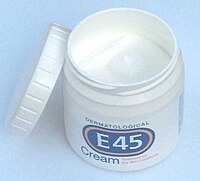
Photo from wikipedia
BACKGROUND Leaf wettability is a major hurdle for retention of agrichemical sprays which is combated, in part, by using adjuvant modified formulations. Scientists must understand the properties of the leaf… Click to show full abstract
BACKGROUND Leaf wettability is a major hurdle for retention of agrichemical sprays which is combated, in part, by using adjuvant modified formulations. Scientists must understand the properties of the leaf surface and the formulation that govern wetting, to intelligently select or formulate products to target specific pests. RESULTS A comprehensive database; comprising 11 synthetic man-made surfaces and 54 leaf surfaces (species, adaxial and abaxial sides, cultivars, and plant age) using 35 formulations (neat solutions, and adjuvants solutions at different concentrations) was compiled. Surface properties of the physical roughness and chemical polarity, as quantified by the wetting tension dielectric method, and formulation properties of surface tension and polarity, as quantified by dielectric constant, were found to govern wetting. A comprehensive wetting model was developed, employing these variables, capable of accurately predicting the wetting outcome (R2 = 0.86) on all the leaf and synthetic surfaces investigated. This model adequately predicts adjuvant formulation wetting despite exact formulation polarity being unknown. CONCLUSIONS Wetting can be modelled for a wide range of surfaces and solutions. The comprehensive wetting model developed shows potential to better predict the wetting outcome of adjuvant formulations should a method to quantify formulation dielectric constant be developed. This research provides a significant advancement in the understanding of the properties governing wetting, which may aid the selection, and development, of adjuvants to target specific surfaces. This article is protected by copyright. All rights reserved.
Journal Title: Pest management science
Year Published: 2022
Link to full text (if available)
Share on Social Media: Sign Up to like & get
recommendations!